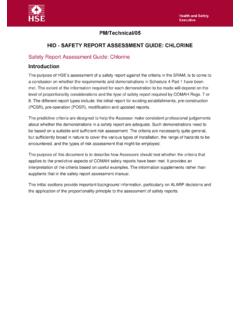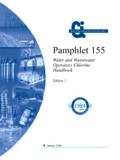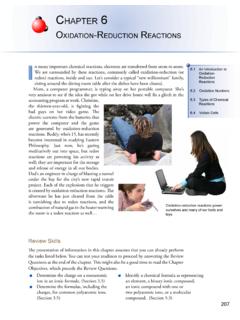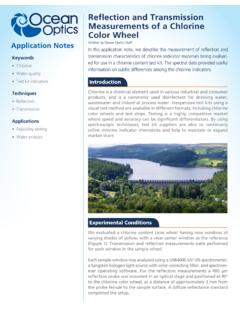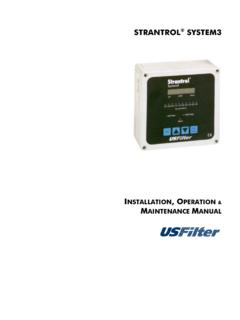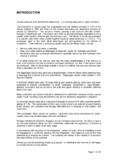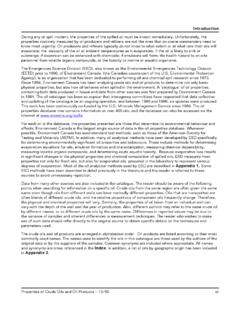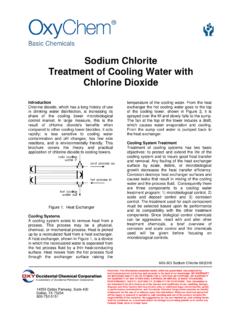Transcription of CONSULTATIONS AND WORKSHOPS
1 CONSULTATIONS AND WORKSHOPS Benefits and Risks of the Use of chlorine -containing Disinfectants in Food Production and Food Processing Report of a Joint FAO/WHO Expert Meeting Ann Arbor, MI, USA, 27 30 May 2008 Use of chlorine -containing Disinfectants in Food Production and Food Processing WHO Library Cataloguing-in-Publication Data Benefits and risks of the use of chlorine -containing disinfectants in food production and food processing: report of a joint FAO/WHO expert meeting, Ann Arbor, MI, USA, 27 30 May 2008. contamination. - toxicity. - toxicity. - utilization. hygiene - standards. assessment. Health Organization. and Agriculture Organization of the United Nations.
2 ISBN 978 92 4 159894 1 (NLM classification: WA 701) ISBN 978 92 5 106476 4 FAO and WHO 2009 All rights reserved. Publications of the World Health Organization can be obtained from WHO Press, World Health Organization, 20 Avenue Appia, 1211 Geneva 27, Switzerland (tel.: +41 22 791 3264; fax: +41 22 791 4857; e-mail: Requests for permission to reproduce or translate WHO publications whether for sale or for noncommercial distribution should be addressed to WHO Press, at the above address (fax: +41 22 791 4806; e-mail: The designations employed and the presentation of the material in this publication do not imply the expression of any opinion whatsoever on the part of the Food and Agriculture Organization of the United Nations (FAO) or of the World Health Organization concerning the legal status of any country, territory, city or area or of its authorities, or concerning the delimitation of its frontiers or boundaries.))
3 Dotted lines on maps represent approximate border lines for which there may not yet be full agreement. The mention of specific companies or of certain manufacturers products does not imply that they are endorsed or recommended by the FAO or the World Health Organization in preference to others of a similar nature that are not mentioned. Errors and omissions excepted, the names of proprietary products are distinguished by initial capital letters. All reasonable precautions have been taken by the World Health Organization to verify the information contained in this publication. However, the published material is being distributed without warranty of any kind, either expressed or implied.
4 The responsibility for the interpretation and use of the material lies with the reader. In no event shall the FAO or the World Health Organization be liable for damages arising from its use. Printed by the WHO Document Production Services, Geneva, Switzerland CONTENTS ACKNOWLEDGEMENTS .. viii EXECUTIVE SUMMARY .. ix 1. USE OF chlorine -CONTAINING COMPOUNDS IN FOOD PROCESSING ..4 Introduction ..4 Poultry processing ..6 Initial loads of bacteria upon entry to Cross-contamination of carcasses during Control of contamination during Chemical ..7 Effectiveness of control measures ..7 Evaluating the chlorine -based chemicals (Tables and ).
5 8 Non- chlorine -based alternatives (Tables and ) ..10 Red meat processing ..12 Primary red meat Effectiveness of chlorine -based control measures (Tables and ) ..13 Effectiveness of non- chlorine -based alternatives (Table )..14 Further red meat Sources, types and control of Effectiveness of chlorine -based control Effectiveness of non- chlorine -based Fish and fishery product processing ..16 Types of chlorine compounds used in fish processing ..17 Industry practices ..19 chlorine -based solutions for non-product contact Non- chlorine -based alternatives ..22 Summary.
6 22 Fresh fruits and vegetables ..23 Leafy Initial load of bacteria upon entry to processing ..23 Control of contamination during processing ..24 Effectiveness of control measures ..25 Hydroponic fresh Sprouts and sprouting chlorine -based interventions ..28 Non- chlorine -based alternatives ..28 Food contact surfaces ..29 Disinfection of food contact surfaces using chlorine -based iii Use of chlorine -containing Disinfectants in Food Production and Food Processing Function and target microorganisms ..29 Active chlorine compounds Treatment conditions ..30 Effectiveness of the process.
7 31 Limitations of the Disinfection of food contact surfaces using non- chlorine -based alternative compounds ..33 Alternative compounds used ..33 Treatment conditions ..33 Effectiveness of alternative compounds ..33 Limitations of alternative compounds ..35 References ..36 2. CHEMISTRY OF DISINFECTANTS AND FORMATION OF DISINFECTION BY-PRODUCTS IN FOOD AND Introduction ..48 Acidified sodium chlorite ..48 Chemistry ..48 Application and fate in foods ..49 Reactions of acidified sodium chlorite with food Summary ..52 N-Chloramine chemistry ..52 Application and fate in foods ..53 Nitrosamine residues in chlorine dioxide.
8 56 Chemistry ..56 On-site generation of chlorine dioxide ..56 Application and fate in foods ..57 Fresh produce ..57 Poultry and red Fish and other seafood ..58 Reactions with food components ..58 Summary ..60 Hypochlorite-related compounds ( chlorine gas, sodium hypochlorite, calcium hypochlorite, hypochlorous acid, hypochlorite ion) ..60 Chemistry ..60 Chemistry of chlorine interactions with organic matter ..62 Disinfection by-products in Disinfection by-products in Other reactions with foods ..68 Sodium dichloroisocyanurate ..68 Chemistry ..68 Application and fate in foods ..68 1,3-Dibromo-5,5-dimethylhydantoin (active bromine).
9 69 Chemistry ..69 Application and fate in foods ..69 DMH ..69 ivUse of chlorine -containing Disinfectants in Food Production and Food Processing Bromide ..70 Trihalomethanes ..70 Bromate ..70 Brominated and iodinated compounds ..71 Summary ..71 Ethyl lauroyl arginate ..71 Ozone (active oxygen)..72 Chemistry and preparation ..72 Application and fate in foods ..73 Summary ..74 Peroxyacids and peroxides ..74 Chemistry of peroxyacids and hydrogen peroxide ..74 Application and fate in foods ..75 Summary ..76 Quaternary ammonium compounds (including cetylpyridinium chloride) ..76 Cetylpyridinium chloride.
10 76 Iodophors ..77 Sodium Trisodium phosphate ..78 Other considerations ..78 Vaporization and loss of residue chemicals ..78 Opportunities for further studies ..79 References ..79 Appendix A: Data on nitrosamines in foods ..88 Appendix B: Drinking-water guidelines and 3. CHEMICAL RISK ASSESSMENT ..91 Toxicology and exposure Chemical risk assessment ..91 Dietary exposure assessment for foods (other than drinking-water) ..91 Dietary exposure assessment for Other information ..92 chlorine -containing disinfectants ..92 Acidified sodium chlorite ..92 Chloramine (monochloramine)..94 chlorine dioxide.










